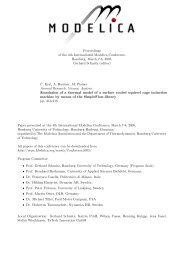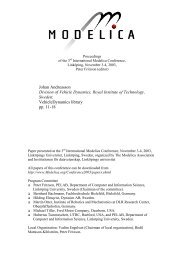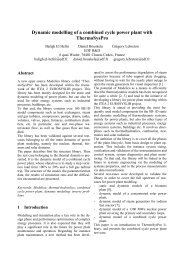The New Object-Oriented Modeling Language - Modelica
The New Object-Oriented Modeling Language - Modelica
The New Object-Oriented Modeling Language - Modelica
You also want an ePaper? Increase the reach of your titles
YUMPU automatically turns print PDFs into web optimized ePapers that Google loves.
ities and sampled systems. <strong>The</strong> design should be extendible<br />
in order that the goal can be expanded to design<br />
a multi-formalism, multi-domain, general-purpose<br />
modeling language.<br />
<strong>The</strong>re is a need to consider extensions of <strong>Modelica</strong> for<br />
handling of partial differential equations, discrete event<br />
models, etc. Some of these areas are discussed below.<br />
Partial Differential Equations<br />
<strong>The</strong> underlying laws of a model of a technical system are<br />
often of the form of partial differential equations (PDE).<br />
<strong>The</strong> DAE form is then an approximation where certain<br />
quantities are considered independent of the spatial coordinates<br />
within a certain object. For certain phenomena<br />
like heat conduction, convection, laminar and turbulent<br />
flows, and vibrations in flexible mechanical structures,<br />
more accurate PDE models might be needed to<br />
capture the detailed behavior.<br />
A PDE model is defined by (1) a partial differential<br />
equation, (2) the domain of validity of the PDE and<br />
(3) boundary conditions for spatial borders and initial<br />
conditions. <strong>The</strong> domain of validity is typically a geometrical<br />
domain in 1–3 dimensions. A variety of geometry<br />
formats are used by different CAD software. To support<br />
exchange it is necessary to have an application independent<br />
format for representing geometry in <strong>Modelica</strong>.<br />
Discrete Event Models<br />
Further model approximations are done when quantities<br />
are considered to be constant over intervals of time,<br />
i.e., when dealing with discrete event models. <strong>Modelica</strong><br />
already have features for handling discrete variables<br />
and describe how they are changed. However, many issues<br />
of standard discrete event packages have not been<br />
considered yet, such as: function library for various random<br />
distributions, queue handling, how to gather statistical<br />
information, processes and their interaction, animation<br />
features, etc. It would be possible to extend<br />
<strong>Modelica</strong> with such features. However, there are also<br />
many different formalisms for discrete event modeling,<br />
such as: process oriented, activity oriented, Petri nets,<br />
Grafcet, DEVS, State charts and VHDL (discrete circuit<br />
modeling). <strong>The</strong>re are also many discrete event programs<br />
available. In certain cases, modeling is done in a standard<br />
programming language like C++ or Java with the<br />
use of a library of standard functions. Probably, <strong>Modelica</strong><br />
should be both extended with basic discrete event<br />
features, as well as having appropriate interfaces defined<br />
for coupling to external discrete event packages.<br />
Simulator Environment<br />
Most issues about simulating a <strong>Modelica</strong> model is<br />
an internal matter for the simulator. However, for<br />
hardware-in-the-loop simulation one typically needs to<br />
specify which fixed step-size algorithm and what stepsize<br />
to use. <strong>The</strong>re is also a need to specify the coupling<br />
to external input and output hardware. To make such<br />
information portable, a notation in <strong>Modelica</strong> is needed.<br />
In cases when a <strong>Modelica</strong> model, for example, needs to<br />
access medium properties from a data base or be simulated<br />
simultaneously with models in other programs<br />
like a discrete event package, a finite element package<br />
or in a network performing distributed interactive simulation<br />
(DIS), certain information needs to be exchanged.<br />
Such specification needs to be portable, i.e., language<br />
notations are needed in <strong>Modelica</strong>. A possibility would<br />
be to use the High Level Architecture, HLA.<br />
<strong>The</strong>re are also cases when the model description needs<br />
to be augmented in order to help the tool achieve<br />
fast enough simulation. An example is to partition the<br />
model and use multi-rate integration, i.e., to integrate<br />
parts of a model with fast dynamics with shorter stepsize.<br />
Another example is the ability to help the tool<br />
partition the model for execution on different processors<br />
in a parallel architecture. For models with changing<br />
topology, there might also be a need to specify which<br />
configurations are useful. A model with 10 switches can<br />
be in 1024 different modes. If the modeler knows that<br />
maybe only 20 modes are actually used, more efficient<br />
code can be generated than would be possible for the<br />
general case of 1024 modes.<br />
Experiment Specification<br />
When using a mathematical model for simulation or<br />
optimization, the model itself is only a part of the<br />
problem specification. Parameter values, initial values,<br />
start time, stop time or stop condition and how to treat<br />
the result of the simulations are also needed. On a more<br />
lower level it may be of interest to specify solvers and<br />
their parameters.<br />
<strong>The</strong> separation of model, integration algorithm and experiment<br />
is common since a long time. However, what<br />
constitute an experiment is not always obvious. Does a<br />
change of a model parameter belong to an experiment<br />
or to a model? Sometimes the environment of the system<br />
under study is described by some input signals connected<br />
to the model. In certain cases, the “environment”<br />
is described as a dynamic model, i.e., the full power of<br />
<strong>Modelica</strong> is needed. Similarly, describing an optimization<br />
criterion typically contain integration that can be<br />
converted to a differential equation. Even hybrid features<br />
might be needed, for example, to define a maximum<br />
of a signal accurately would involve checking for<br />
the sign shift of the derivative of the signal.<br />
Issues like handling of parameter sets, functions defined<br />
by tables, coupling of inputs, how initialization should<br />
be done, definition of an optimization problem, etc.<br />
needs to be portable between different tools. This means<br />
that <strong>Modelica</strong> should be extended in these directions.<br />
User Environment<br />
<strong>Modelica</strong> already has provisions to describe the graphical<br />
layout of icons and connection topology by means of<br />
annotations. So far, only static pictures have been considered.<br />
When using models for operator training, typically<br />
a live process layout is used to show the status of<br />
4
















